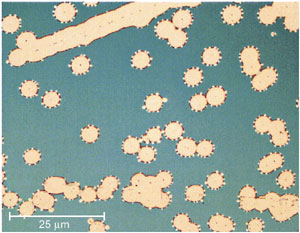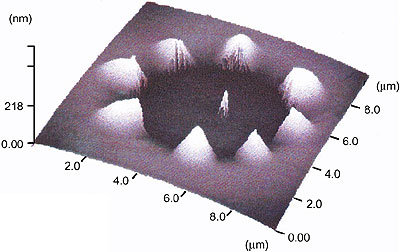Carbon-related substances are known to be incorporated into a broad range of materials typical of the living environment and are also utilized in nanotechnology. In particular, diamond films are expected to play an increasingly important role in expanding the current demand for carbon-related materials.
The ion beam deposition technique has been employed to synthesize high quality carbon films using the ion bombardment effect. In this technique, mass-separated 12C+ ions with energies of 10 (100 eV are landed softly on crystalline substrates under ultra high vacuum conditions by applying a retarding potential. In this study, the synthesis of carbon films with a high sp3 bonding fraction was achieved by optimizing the deposition parameters such as bombardment energies, ion species, type of substrate, and substrate temperature.
After some experimentation, we concluded that amorphous carbon films with the highest sp3 fraction (80%) could be prepared by simply bombarding with 100 eV 12C+ at room temperature. Next, we found it interesting to study the refractory properties of these films. Amorphous carbon films deposited on Si generally showed a refractive nature, but started to be graphitized after annealing at 700 degrees cent. The result is different from the case of an Ir substrate. The flaking off of circular amorphous carbon regions occurred even with annealing at 400 degrees cent., but the intact area retained its sp3 bonding nature. On subsequent rapid cooling, small, flower-like blisters were induced around the circular flaking region. This effect can be attributed to the instability of high speed deformation when cooling (Fig. 4-6). The enlarged feature of circular flaking can be imaged with an atomic force microscope as in Fig. 4-7. In this photo one can see a small needle with an average diameter of 200 nm at the center. This needle stems from lattice imperfections in the Ir crystalline substrate. The needle was identified to have the composition of diamond by micro-Raman spectroscopy.
From the detailed analysis described above, it has been concluded that supersaturated carbon atoms deposited near the surface region by ion beam deposition tend to nucleate as diamond, so as to meet the requirements
of heteroepitaxy at points of crystal imperfection.
The nanodiamonds shown in Fig. 4-7 have a topological advantage as electron guns with high brilliance, because of their natural shapes. Further efforts utilizing the self-organization process will be made to control the arrangement of nanodiamonds for possible application to new devices requiring a regular array of brilliant electron guns or micro-lasers. |


